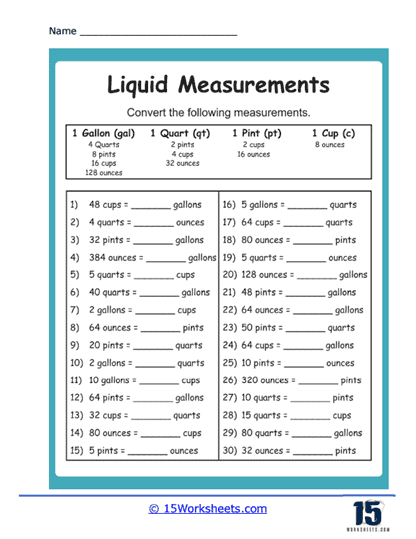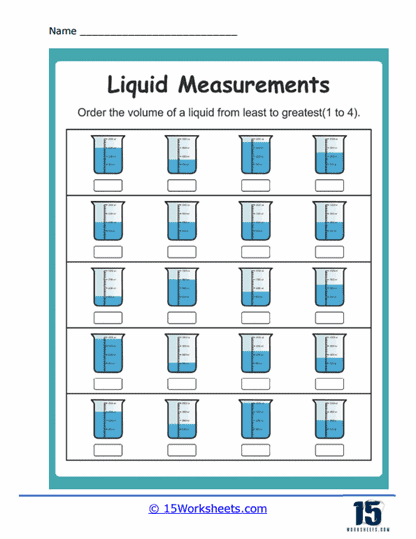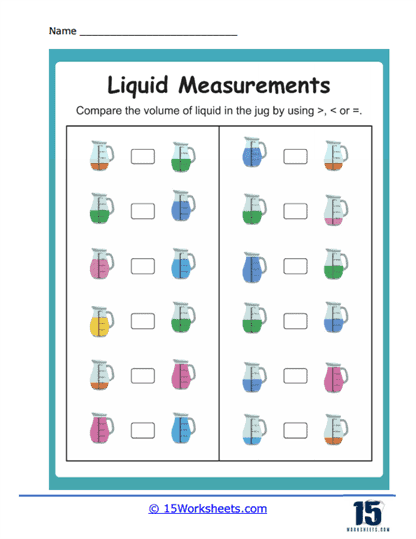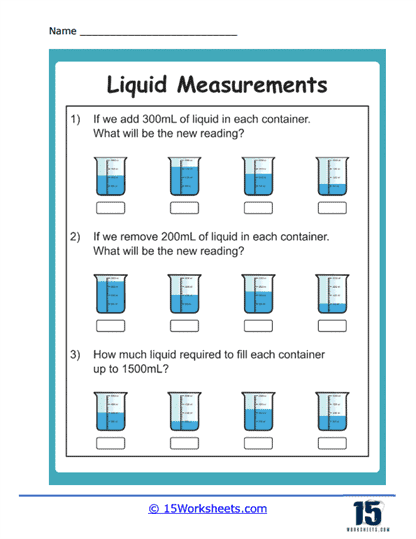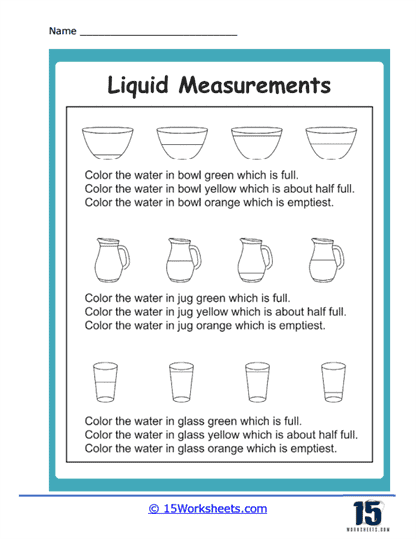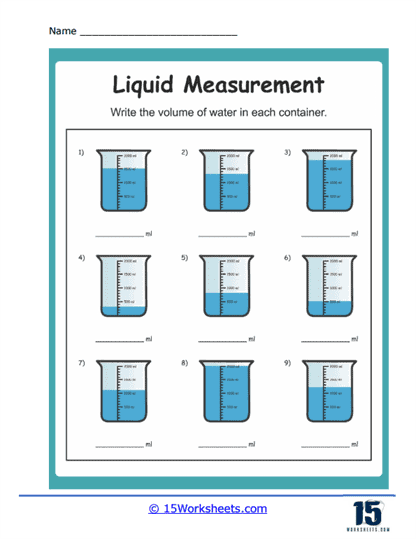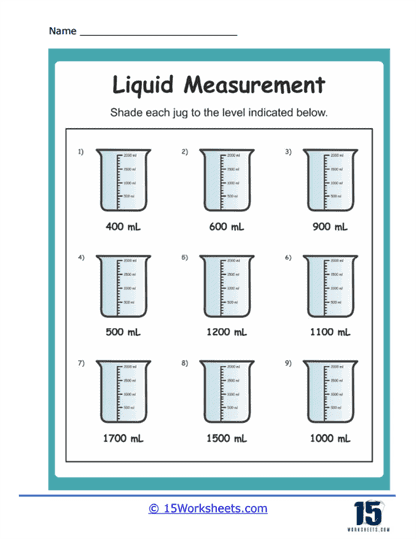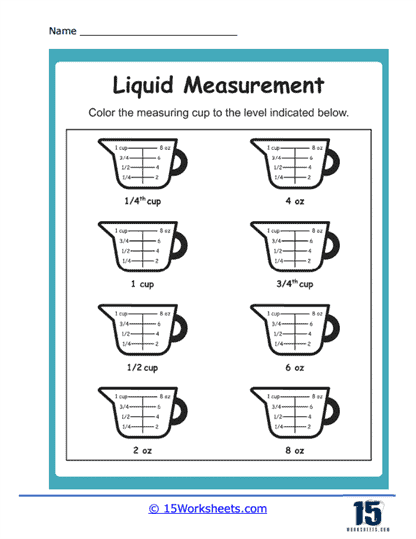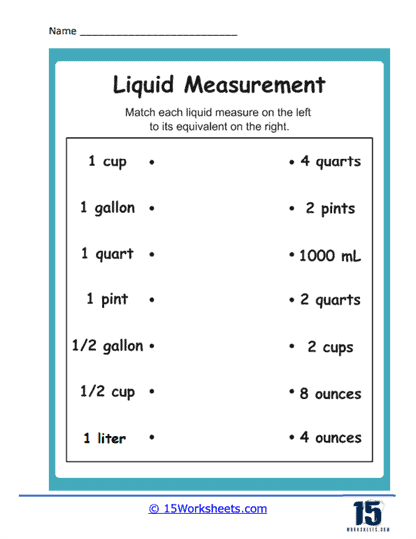Measuring Liquids Worksheets
About These 15 Worksheets
Understanding volume, particularly in the context of liquids, is an essential skill that has practical implications in daily life as well as in scientific endeavors. The goal of this series of worksheets is to help introduce and reinforce the concept of measuring the volume of liquids. These worksheets typically provide exercises that range from introductory lessons about liquid units of measurement to more complex tasks involving calculations and real-world applications. The primary focus is on helping students develop an understanding and proficiency in measuring and conceptualizing the volume of liquids.
Types of Exercises on These Worksheets
Understanding Liquid Measurement Units – Introductory exercises usually acquaint students with units used to measure liquids, such as milliliters, liters, fluid ounces, cups, pints, quarts, and gallons. This helps familiarize students with various units of liquid volume and offer a foundational understanding of each unit’s magnitude.
Reading Graduated Cylinders and Beakers – Students are given images of graduated cylinders or beakers with liquids at various levels and are tasked with reading and interpreting the volume. This develops skills in accurately reading scientific tools commonly used to measure liquids and understand the gradations on these tools.
Estimating Liquid Volumes – Before using any tools, students might be asked to estimate the volume of liquid in a container and then compare their estimate to the actual measurement. These types of problems can help cultivate student intuition for liquid volumes and enhance estimation skills.
Converting Between Liquid Units – Problems might challenge students to convert volumes from one unit to another, like from milliliters to liters or from cups to gallons. This reinforces for students the relationships between different units of liquid volume and improve calculation skills.
Practical Measurement Scenarios – Exercises might involve real-world contexts, such as cooking or chemistry, where students need to measure, mix, or compare different volumes of liquids. This types of problems can help illustrate the importance and application of liquid measurement in everyday situations and professional fields.
Comparing Liquid Volumes – Exercises might present two containers and ask which holds more, or they may provide various containers and request students to rank them based on their volume. This task can help students sharpen their analytical thinking skills and deepen comprehension of relative volumes.
Mixing Liquids – Advanced worksheets may have tasks where students measure and mix liquids of different volumes to achieve a target volume or concentration. This introduces students to the concepts of ratios, concentration, and proportionality in a tangible, hands-on manner.
What Do These Worksheets Teach Students?
Basic Concepts – These worksheets introduce the fundamental idea of liquid volume and the standardized units we use to measure it.
Tool Proficiency – Through exercises centered on graduated cylinders, beakers, and other containers, students become adept at using and reading various measuring tools.
Analytical Thinking – By estimating, comparing, converting, and mixing liquids, students exercise and refine their analytical thinking and reasoning abilities.
Unit Relationships – Conversion exercises instill a solid understanding of how different liquid measurement units relate to each other.
Practical Application – Real-world scenarios, especially those involving cooking or laboratory settings, underscore the importance of accurate liquid measurement in daily tasks and professional activities.
Mathematical Integration – Beyond mere measurement, these worksheets often integrate arithmetic, ratios, and sometimes even algebraic reasoning, broadening the student’s mathematical skill set.
Scientific Foundation – Accurate liquid measurement is crucial in many scientific experiments. By mastering these worksheets, students are better prepared for advanced studies in chemistry, biology, and other sciences.
These worksheets can be a valuable tool for equipping students with both the theoretical knowledge and practical skills needed to measure liquid volumes effectively. As students progress through these exercises, they not only become adept at the act of measurement but also develop a deeper appreciation for the precision and structure that govern our understanding of the world. Whether in the kitchen, the laboratory, or beyond, the skills honed through these worksheets prove invaluable in many facets of life and study.






